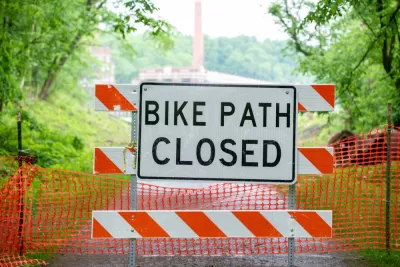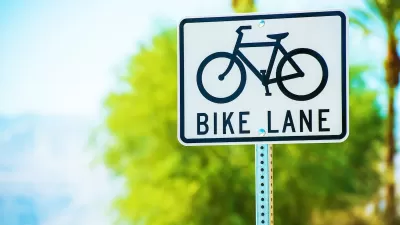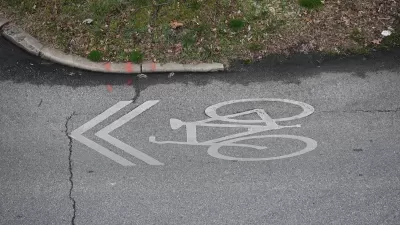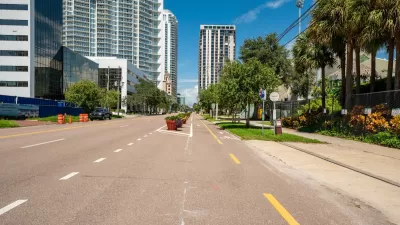After a recent death on the White Oak Trail, Houston bike advocates say closure markers on the city’s bike trails are often inconsistent and hard to see, posing a danger for cyclists at night.

Houston bike activists are calling on the city to improve safety on bike trails, particularly when it comes to marking trail closures and construction areas, after the death of a cyclist last week, reports Dug Begley in the Houston Chronicle. Matthew Ledvina died after being found sprawled in the middle of the White Oak Trail with his bicycle and orange construction netting nearby.
While the cause of Ledvina’s death is as yet unclear, other Houston cyclists say trail closures are often poorly marked and difficult to see at night. “Tuesday evening, five days after the crash, the netting had been adorned with strips of yellow caution tape and a homemade sign warning of the danger.” Local cyclists and walkers were observed ignoring the netting to avoid the detour.
Begley adds that “Wednesday, after cyclists raised concerns and the city and county were asked about the design of the closing, workers placed reflective warning barriers commonly used on streets along the trail as an extra measure where the path is blocked.”
Begley points out that there are no standardized regulations for closures or detours on bike and pedestrian trails, with only a brief mention of signage for bike trail closures in the city’s design manual. “‘There seems to be a complete dearth of regulations for signage, warnings and other laws,’ said Charlie Thomas, a Houston lawyer who often represents cyclists injured in crashes, as part of the national Bike Law Network.”
FULL STORY: White Oak Trail cycling death prompts questions on trail closings

Alabama: Trump Terminates Settlements for Black Communities Harmed By Raw Sewage
Trump deemed the landmark civil rights agreement “illegal DEI and environmental justice policy.”

Planetizen Federal Action Tracker
A weekly monitor of how Trump’s orders and actions are impacting planners and planning in America.

The 120 Year Old Tiny Home Villages That Sheltered San Francisco’s Earthquake Refugees
More than a century ago, San Francisco mobilized to house thousands of residents displaced by the 1906 earthquake. Could their strategy offer a model for the present?

In Both Crashes and Crime, Public Transportation is Far Safer than Driving
Contrary to popular assumptions, public transportation has far lower crash and crime rates than automobile travel. For safer communities, improve and encourage transit travel.

Report: Zoning Reforms Should Complement Nashville’s Ambitious Transit Plan
Without reform, restrictive zoning codes will limit the impact of the city’s planned transit expansion and could exclude some of the residents who depend on transit the most.

Judge Orders Release of Frozen IRA, IIJA Funding
The decision is a victory for environmental groups who charged that freezing funds for critical infrastructure and disaster response programs caused “real and irreparable harm” to communities.
Urban Design for Planners 1: Software Tools
This six-course series explores essential urban design concepts using open source software and equips planners with the tools they need to participate fully in the urban design process.
Planning for Universal Design
Learn the tools for implementing Universal Design in planning regulations.
Clanton & Associates, Inc.
Jessamine County Fiscal Court
Institute for Housing and Urban Development Studies (IHS)
City of Grandview
Harvard GSD Executive Education
Toledo-Lucas County Plan Commissions
Salt Lake City
NYU Wagner Graduate School of Public Service





























